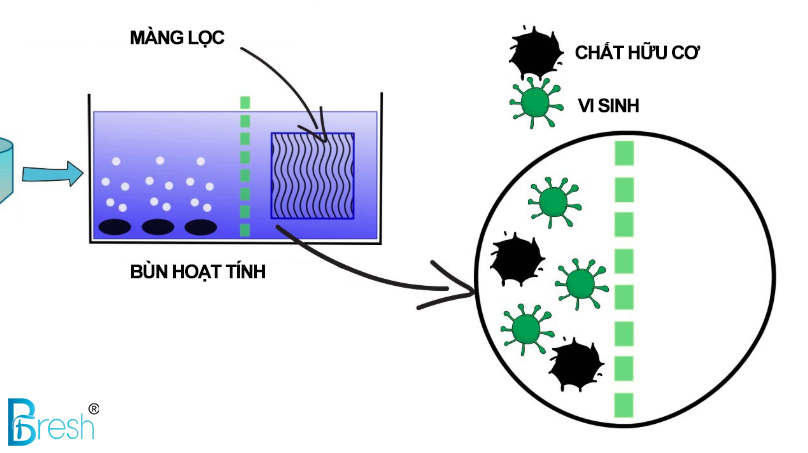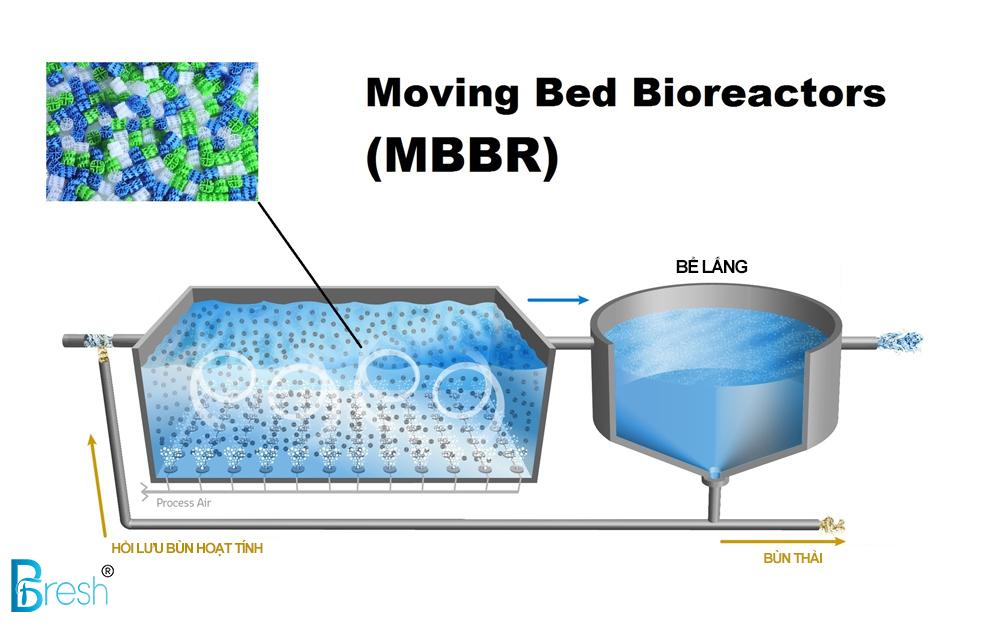Wastewater treatment technologies
Scientists have discovered many advanced wastewater treatment technologies. Applicable to many different types of wastewater. So what are the wastewater treatment technologies, let's follow Biofix!
Physico-chemical wastewater treatment technology combined with biology
This technology has been around for a long time, but its popularity is still widely used today.
The mechanism of the physico-chemical method is to introduce a certain reactant into the wastewater. This substance reacts with the dirt in the wastewater. The resulting substance is a solid that can be removed from the water through sediment, or a soluble form that is not harmful to the environment.
Commonly used physico-chemical treatment methods: coagulation, adsorption, extraction, sedimentation, ...
MBR biological membrane treatment technology
MBR (Membrane Bio-Reator: biological filter tank using membrane) is a system for microbiological treatment of wastewater using membrane filtration technology.

The application of MBR membrane filter is a combination of membrane filtration technology and biological tank. It is a step in the wastewater treatment process that can replace the role of separating the residue of the secondary sedimentation tank and the input water filter tank. Therefore, it is possible to eliminate the secondary sedimentation tank, the disinfection tank and operate with a higher MLSS concentration, which will save the area of the biological tank.
The application of MBR membrane filter technology gives better and more stable water quality after treatment than traditional microbiological technology. The treated water can be reused.
AAO treatment technology
What is AAO treatment technology?
A/A/O technology stands for Anerobic - Anoxic - Oxic. AAO technology is a continuous biological treatment process, combining 3 microbiological systems: anaerobic, anoxic, aerobic to treat wastewater. Under the impact of decomposing pollutants by microorganisms, wastewater will be treated before being discharged into the environment
Advantages of AAO technology:
Low investment and system costs include: construction, air blowers, submersible mixers, pumps, ...
Generates less sludge than other aerobic biological technologies
Water quality meets A or B standards, depending on the design goal
Low energy consumption
MBBR wastewater treatment technology
What is MBBR technology?
MBBR (Moving Bed Biofilm Reactor) technology is a combination of two techniques: microorganisms attached to fixed materials and suspended microorganisms. In this technology, wastewater is first treated in the MBBR tank. Then in the traditional activated sludge equipment.

This combination has optimized MBBR to reduce BOD in wastewater by 45-70%. Before entering the activated sludge treatment equipment in the back. The activated sludge design is designed to be smaller, because it only solves the problem of treating organic substances.
The activated sludge is circulated from the secondary sedimentation tank to the head of the activated sludge tank, provisions can be provided to allow a part of the activated sludge to be circulated to the MBBR tank. Therefore, it is possible to create a collection tank that is effective for controlling the phenomenon of floating microorganisms. Other advantages of MBBR technology are the ability to withstand sudden increases in input load as well as other toxic compounds.
MBBR technology is optimized for a small land area treatment area, suitable for the requirements of high quality wastewater discharge with large loads, as well as for future expansion of the treatment scale.
Advantages of MBBR technology:
Withstand high organic loads, 2000 -10000gBOD/m3 day, 2000 - 15000gCOD/m3 day.
BOD treatment efficiency up to 90%
Remove Nitrogen in wastewater
Save space
Biofix provides microorganisms imported from the US with a high density of 5 billion CFU/gram. Promotes rapid decomposition of organic matter. Helps reduce COD, BOD,... in wastewater. With a team of professional technicians from North to South, always ready to support customers.
Bài viết liên quan

Propagating the Circular Economy Model in Military Units
BioFix Fresh joins in propagating the circular economy model, a military hold event to share biotech solutions for organic and wastewater treatment.
05-06-2025

BioFix Fresh Promotes Circular Economy at Navy Brigade 167
BioFix Fresh participated in promotes circular economy at Navy Brigade 167 and the event to share biotech solutions for organic and wastewater treatment.
05-06-2025

BioFix Fresh tổ chức thành công Seminar "Kỷ nguyên sinh học trong dịch vụ lưu trú" tại Đà Nẵng
BioFix Fresh tổ chức thành công Seminar "Kỷ nguyên sinh học trong dịch vụ lưu trú" tại Đà Nẵng
05-06-2025

BioFix Fresh attends VITAS' 25th anniversary celebration
BioFix Fresh tham gia lễ kỷ niệm 25 năm thành lập VITAS
05-06-2025

Summary of effective and thorough fat treatment methods
Is your drainage system clogged with grease giving you a headache? Check out these effective and thorough grease removal methods that are commonly used.
14-11-2024

Grease-treating microorganisms - effective treatment of clogged pipes
Learn about grease-treating microorganisms - the most effective solution for unclogging pipes today. Suggest some microbial preparations that are highly effective in treating grease.
14-10-2024

The most effective way to compost manure
Manure is an organic fertilizer from livestock and poultry manure, often mixed with straw. This fertilizer helps improve soil fertility, provide nutrients for plants, and improve soil structure.
26-07-2024

What is SVI? The role of SVI in wastewater treatment
What is SVI? SVI is the sludge volume index commonly used to measure the characteristics of a mixture of sludge and water or activated sludge (unit is milliliters/gram).
26-07-2024

What is a septic tank? Why periodically add probiotics to a septic tank?
Septic tanks are places that contain solid waste (such as feces, urine, grease, and some other organic waste, etc.) and this waste will be decomposed in the septic tank into liquid form.
26-07-2024

Wastewater treatment technologies
Scientists have found many advanced wastewater treatment technologies. Applicable to many different types of wastewater.
26-07-2024

What is anaerobic biotechnology? How does it work?
Anaerobic biotechnology is a method of using anaerobic microorganisms and facultative microorganisms to decompose organic and inorganic substances in wastewater.
26-07-2024

Impact of excess oil and grease on the wastewater treatment system
Fats, oils and grease from cooking (vegetable oil, meat, milk) enter the drain through the sink, solidifying and causing blockages, broken drains and wastewater treatment problems.
25-07-2024

Operating principle of microbial fat treatment
The habit of pouring grease and leftover food directly into the sink repeatedly every day causes excess grease under the drain pipe to increase, combined with leftover food to clog the drain pipe.
25-07-2024

















